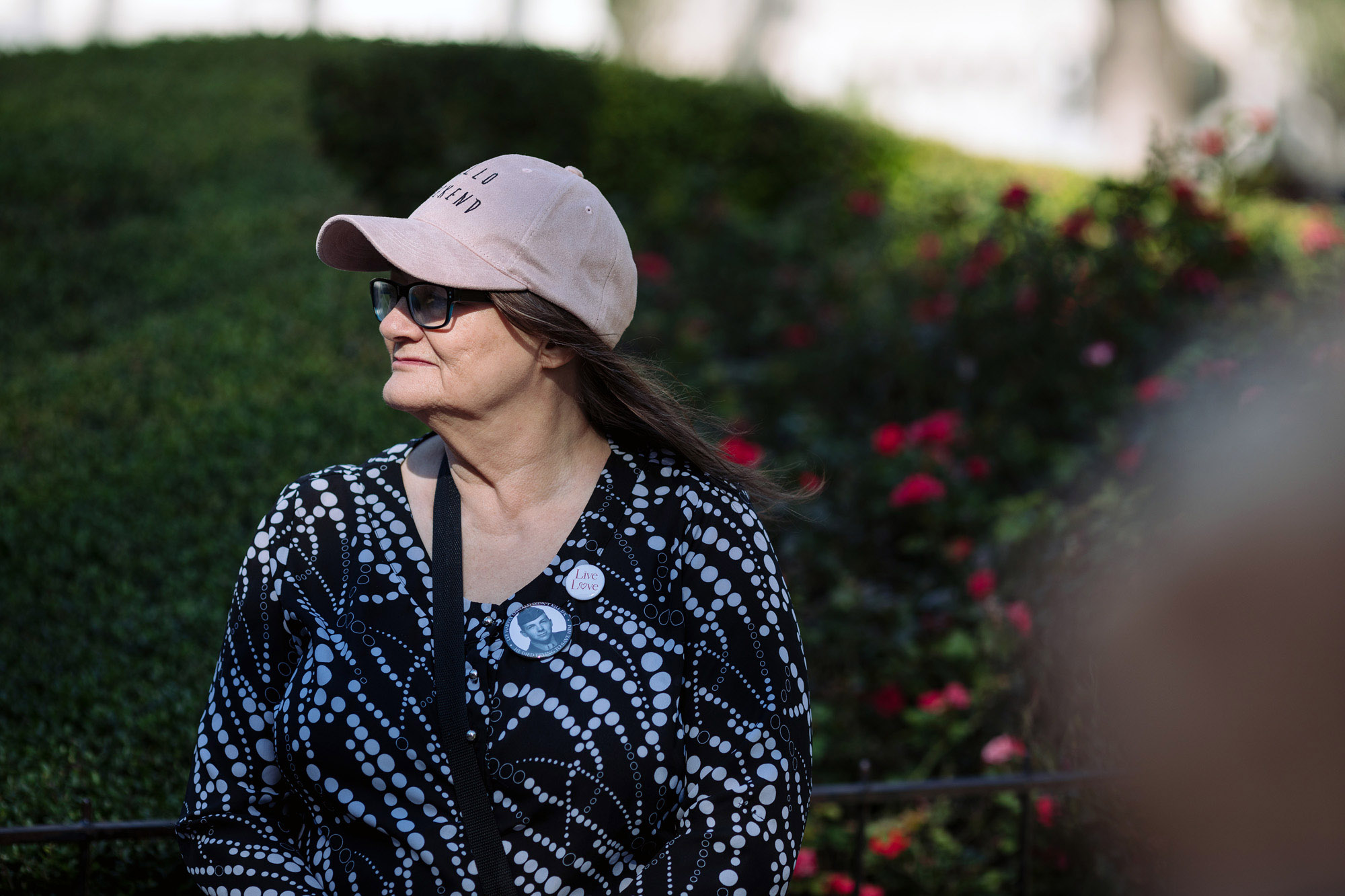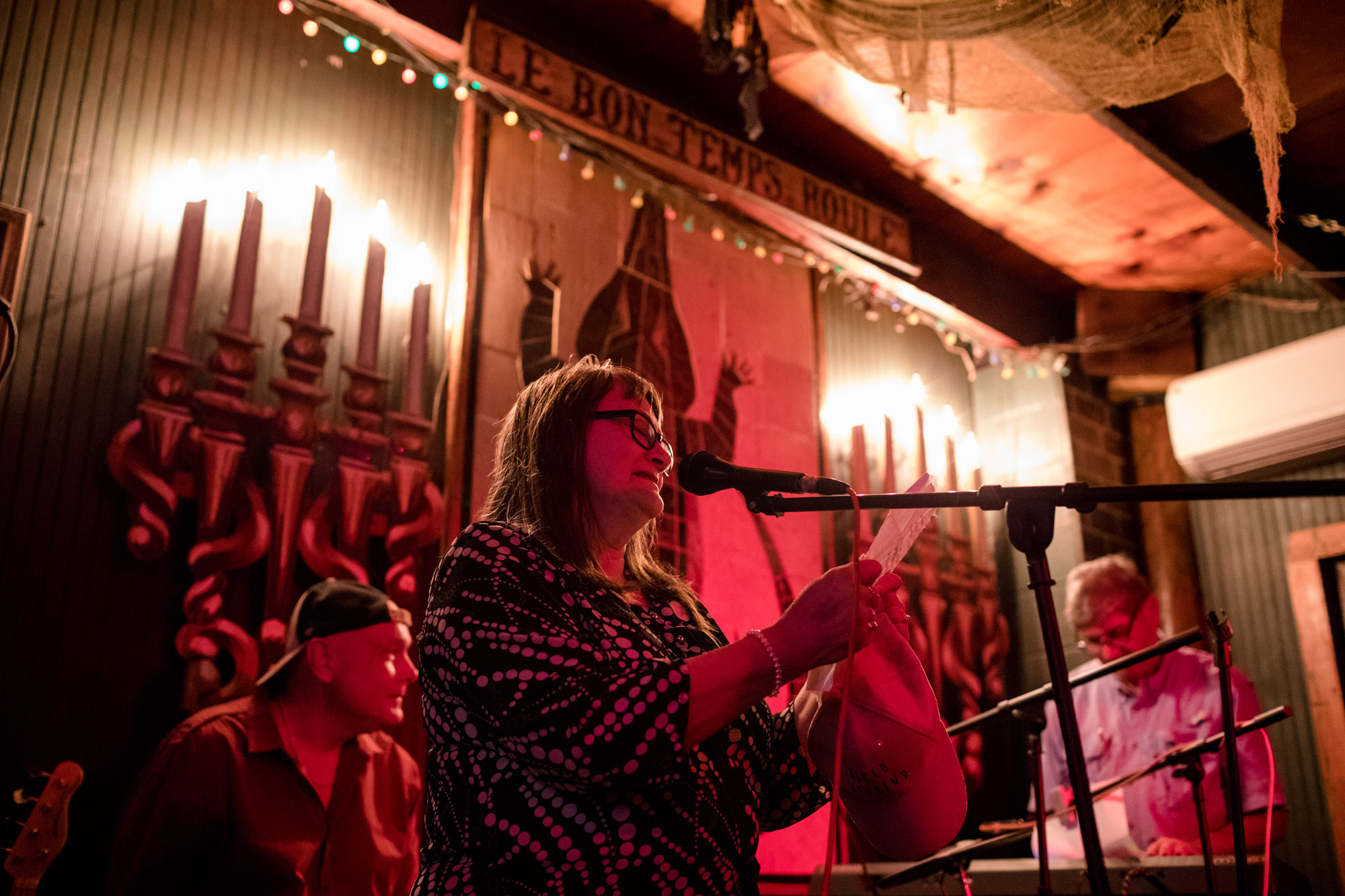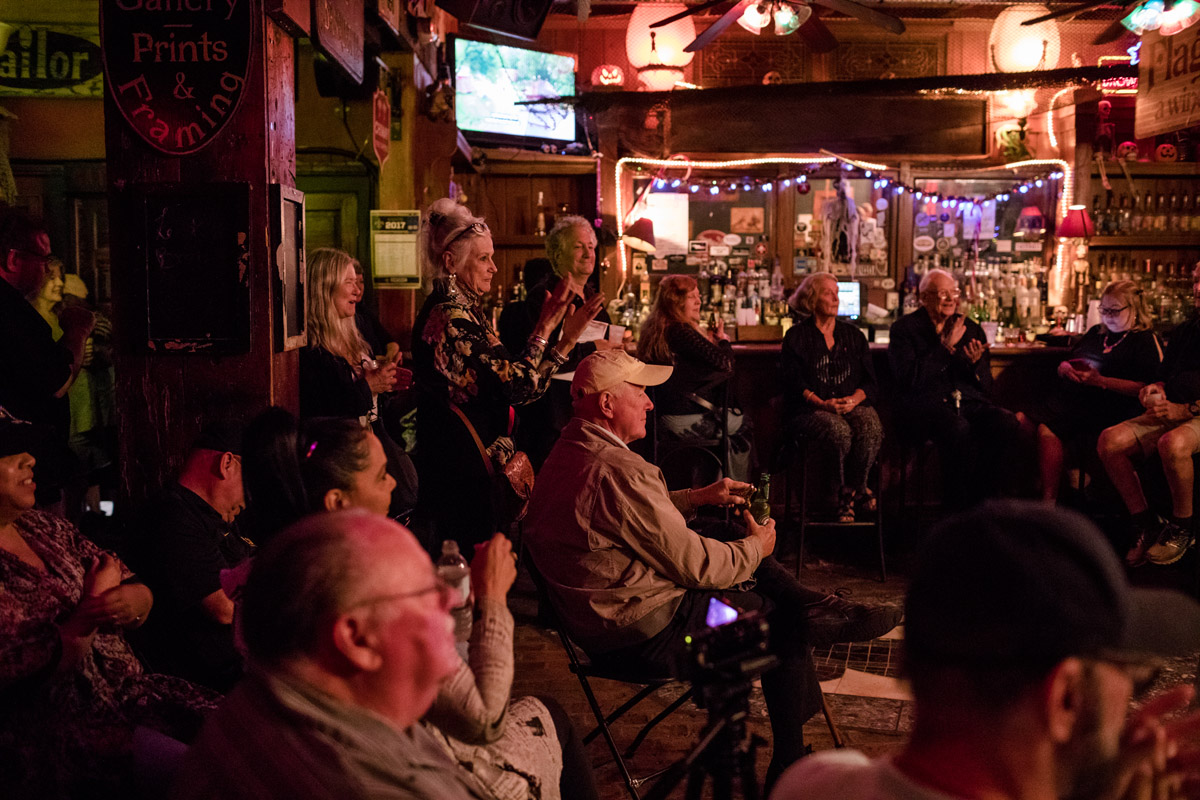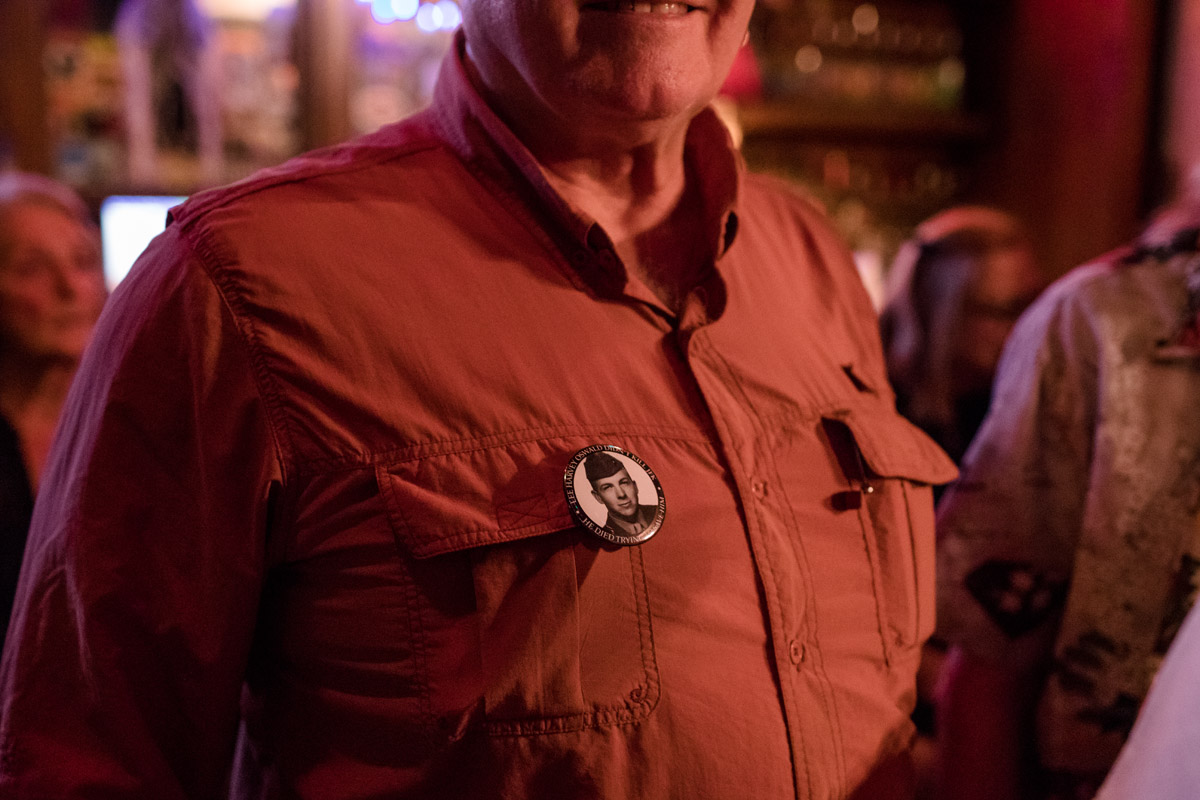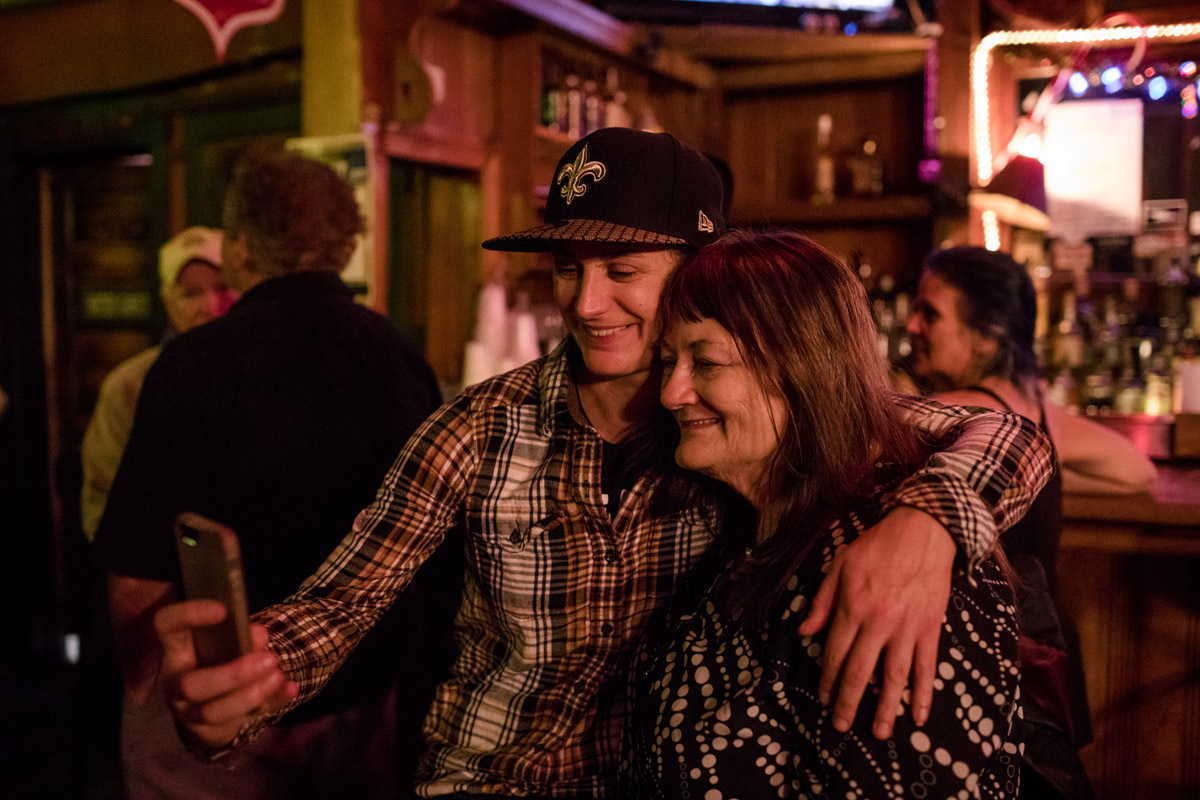A Birthday Party for This Patsy?
Every year in New Orleans, a group assembles to celebrate the birthday of Lee Harvey Oswald, the man who shot President John F. Kennedy. They’re not partying because they hate Kennedy. They’re partying because they think Oswald was framed.
She wore a button the size of a Kennedy half-dollar: pinned to her blouse, fastened just above the heart, imprinted with image and text that were impossible to read from a distance, much less through the scrum of supporters that dogged her every step. Weaving through the congregation of conference attendees — shaking hands, receiving hugs from strangers — she dressed purposefully, solemnly, in black, like a widow in mourning or a person seeking the safety of the clandestine life. But there was no escaping this crowd. They had come to see her, support her, to reach out and touch the arms belonging to Judyth Vary Baker, the woman who once knew and loved Lee Harvey Oswald.
Baker had returned to New Orleans, a city she had once called home, to keynote the First Annual Lee Harvey Oswald Conference, a three-day symposium held in mid-October to coincide with his 76th birthday. Billed as “a weekend dedicated to LHO and proving his innocence,” the conference operated as an alternative to the litany of JFK Assassination conventions held annually throughout the world. This one was designed to appeal to a select breed of assassination buff: the Oswald obsessive.
Over 200 supporters descended on the Crowne Plaza, an airport hotel located on the far suburban frontier of New Orleans — a fringe for the fringe. One man wore a vintage lapel button that read “Hands Off Cuba” — matching the one Lee purportedly donned while handing out leaflets, bearing the same pro-Castro message, on the streets of Dallas and New Orleans 50-plus years ago. Another sported a T-shirt bearing an image of Lee following his arrest on November 22, 1963. His youthful visage stared out, romantic and forlorn, like the frontmen featured on the merchandise purchased at rock concerts. They came to eulogize, humanize, and even lionize one of the most villainized men in American history, the man they all simply and intimately referred to as “Lee.”
Kris Millegan, the conference’s chief organizer, offered a few words of welcome to the attendees. Making clear that separating Lee from the assassination with which he is forever linked is an impossible task, Millegan asserted that the conference would put Lee at the very center of the events of November 22, 1963 — a day he dismissed as simply, “the JFK thing.” The convention’s list of speakers would strive to get at the very heart of Lee, and in doing so, exonerate him from any wrongdoing. The conference’s unofficial catchphrase was “Justice for Lee.” This was our patriotic duty, he reminded us, our obligation as Americans. Achieving that goal — reopening the Kennedy murder case, being the ultimate objective — would be “a huge political act,” said Millegan, “almost like Rosa Parks getting on the bus.”
Judyth Vary Baker, the woman who once knew and loved Lee Harvey Oswald, above. Kris Millegan, the Oswald conference's organizer, below.
Sporting a gray suit and tie, senatorial glasses on a string, and a short ponytail, Millegan is the founder of the Oregon-based TrineDay independent publishing house, which advertises itself as “a little library of suppressed books.” His catalogue includes “Fleshing Out Skull & Bones” and “Overthrow a Fascist Regime on $15 a Day,” among dozens of other titles sure to appeal to a motley confederacy of counterculturists, libertarians, and conspiracy theorists of all stripes. Millegan remembers the day Kennedy was shot: sitting in Mrs. Helser’s eighth-grade Spanish class when that voice came over the loudspeaker. A paperboy, he left school early to hawk copies of the late-afternoon edition. “I had never done that before,” he’s written about that day, “and only did it one more time, two days later when Lee Harvey Oswald was murdered.” Unlike the president, “Lee didn’t have much of a funeral,” Millegan told us on the stage. This weekend would act as his eulogy.
We began with a prayer. “The Bible says all secrets will be revealed,” intoned Chaplain Hy McEnery, director of a local youth ministry. Lee devotees silently filled the windowless hotel ballroom, its walls the dull color of pistachio gelato. “God held truth so highly,” our pastor proceeded, addressing his flock, “so give us understanding as we continue to seek the truth.”
David Denton, the day’s first featured speaker, set the compass for our pursuit of that truth: to reconcile Lee’s brief and violent life with his long and multilayered afterlife. An instructor at Olney Central College in Illinois, where he has taught a course on political assassinations in the 1960s for the past 15 years, Denton said that he advises his students to imagine a different side to Lee, whom he considers the “most mysterious figure in American history.” Lee, the man who history remembers as “one lone nut,” Denton posited, might just be a “hero, instead.”
The past several years — 2013 marked the 50th anniversary of Kennedy’s death, as well as Oswald’s — has seen a voluminous output of Lee-mania, including a biography of his brief stay in the Soviet Union, an investigation into the last 48 hours of his life, an examination of the parallels between Kennedy and Lee by the British cult film director Alex Cox, and a crimson-soaked Stephen King thriller — the basis for a recent miniseries. Our reality show host-turned-Dear Leader, if you remember, even linked a campaign rival’s father to Lee, thus rising to the the top of the heap of conspiracy-filled flim-flam and other tinfoil-hatted nuttiness. In the vast majority of these paranoid fantasies, Lee remains a stooge, a 10-cent sucker armed with a gun that couldn’t shoot straight. He is, in his instantly legendary phrasing, “a patsy,” but to call him a hero suggests, to most, ludicrous delusions.
But he has been called a hero before. Many of the first suspicious of malevolent machinations, which started to unravel even before Kennedy was buried, indefinably characterized Lee as a martyr. Just days after the assassination, Marguerite Oswald told authorities that her son was “the unsung hero of this episode.” Years later, Lee’s Russian-born widow, Marina Prusakova, told an interviewer, “One can be a villain, and next time a hero.” Even Oliver Stone’s “JFK,” the 1991 film that was my own personal introduction to the world of Lee, complete with Gary Oldman’s romantic and spot-on interpretation — capturing Oswald’s every tick, stutter, and shoulder slump — insinuates that Lee sent a telex that attempted to stop the assassination.
But no single individual has endeavored to promote the hagiography of Lee more than the woman who professes to have been his lover during the summer of ’63, Judyth Vary Baker. In a past interview, she said, “Someday, there’ll be a Lee Harvey Oswald action figure. I can see lunch pails with him on it, because he was a heroic person who gave his life for his country.” She’s written a memoir about their relationship, “Me & Lee: How I Came to Know, Love and Lose Lee Harvey Oswald,” a conspiracy-laden thriller meets Harlequin romance. From a table outside the conference, she sold portraits she had painted of her former paramour. In interviews and on her website, Baker still calls Lee “my boyfriend.”
Baker signs copies of her book, "Me & Lee"
Diminutive and wearing thick frames, she looked like a high school librarian. Though her appearance at this conference had been advertised months in advance, each time she stepped into the room her arrival incited a buzz among the crowd. Rumors had circulated that she was living in asylum, fearful for her life because of her prior associations with Lee. Speculation placed her in Sweden, Hungary, and some undefined Middle Eastern country.
For most of the conference’s first day, I failed to decipher the button she wore pinned to her breast, until she began to distribute a sackful of swag to the attendees. She moved down my aisle and handed me a bumper sticker featuring a photo of John F. Kennedy thoughtfully squinting into the distance. Alongside ran one of the president’s most well-worn quotes, an inspirational message perfectly framable for both the dorm room and the boardroom: “One person can make a difference, and everyone should try.” She beamed, nodding encouragingly, as I read Kennedy’s rallying cry aloud. While thanking her, I cautiously snuck a glance toward that button.
It was a devotional in miniature: the wholesome-cheeked face of a beatific young man. He squeaks out an enthusiastic smile despite the tightness of a broad chin strap tethered to a oversized camouflage helmet that appears ready to swallow his head. “Lee Harvey Oswald Didn’t Kill JFK,” the button read, its words arcing above and below his helmeted dome and boyish visage to wreath him in a halo, “He Died Trying To Save Him.”
Over the past half-century, we have spent lifetimes assessing the life of Lee. In September of 1964, the President’s Commission on the Assassination of President Kennedy, aka the Warren Commission, published an 889-page report that detailed not the life of the deceased president but rather the existence of the man who allegedly thrice pulled the trigger that killed him. Two months later, the government published 26 volumes — running over 18,000 pages — of supporting evidence collected by the commission. If we include the records compiled on Lee by the FBI, CIA, and KGB — likely totaling in the hundreds of thousands of pages — his is one of the most documented lives in recorded history.
Baker shares her version of history with other Oswald acolytes.
His mother, Marguerite, began her testimony before the Warren Commission by remembering her son as “a very happy baby.” She names him after his father, Robert E. Lee Oswald, who dies of a heart attack two months before his son’s birth. Growing up in New Orleans during the 1940s, Lee Harvey Oswald is one of hundreds of Lees — thousands if including the whole South — named in honor of the Confederate general, whom he later deems “the greatest man in history.” He struggles with dyslexia, but labors to read books on his favorite subjects: history, animals, and astrology. Later, in Dallas, where he spends his preteen years, he climbs rooftops and, armed with a pair of binoculars, studies the stars.
Late in the summer of 1952, Marguerite and Lee relocate to New York. Within days, he slaps his mom and threatens his half-brother’s wife with a pocketknife. Lee becomes the prized truant of the seventh grade class of Public School 117 — missing 32 of 47 school days. Officers know to find him loitering at the Bronx Zoo, where they arrest him repeatedly. A picture taken from that period shows Lee posing in front of an unmarked animal habitat at the Bronx Zoo. Wearing slicked hair, jeans, a white T-shirt with the sleeves rolled up, he resembles an adolescent James Dean, a rebel still looking for a cause.
He finds that cause in two disparate places: Marx and the Marine Corps. On his 16th birthday, he attempts to enlist with the help of a birth certificate forged by his mother. He is rejected but succeeds the following year, upon reaching the minimum age requirement. The button Judyth Baker wore pinned to her blouse pictured Lee at this moment: a cute kid, all skinny and grinny, young- and sweet-looking, less Marine than Mouseketeer. In the Corps, Lee’s buddies called him Oz, Ozzie, and Ozzie Rabbit, after Walt Disney’s floppy-earned progenitor to Mickey Mouse. But after boot camp, life in the Corps descends like a bad dream. He becomes sullen and is court-martialed twice.
Then, life gets weird. In October 1959, two days before his 20th birthday, Lee defects, arriving in Moscow in a most undramatic fashion: by train, via Helsinki, with a valid visa in hand — an incident seemingly designed to later spark the synapses of conspiracy theorists. His Soviet handlers agree to let him stay, but quickly shuttle him to Minsk, then a wasteland of a provincial city, where he works in an electronics factory, avoids the arctic temperatures from the comfy confines of a government-furnished apartment, and dates local girls, eventually marrying a young pharmacist from Archangel. Because the name Lee sounded too Chinese to most Russians, his friends rechristen him Alik, sometimes Aloysha and Alka. But the KGB code names him Likhoi, one of those untranslatable Russian words used to describe an individual who is dashing, reckless.
The Warren Commission’s papers include copies of such innocuous items as Lee’s infant daughter’s smallpox vaccination certificate and an undated Christmas card sent to his half-brother. We have microphotographs of three of Lee’s pubic hairs (#672) and a pair of photographs of him, age six-and-a-half, happily posing with what might have been his first fish (Pic Exhibit nos. 50-51).
“The only thing we don’t know about Lee Harvey Oswald,” said one speaker, “is whether he had Cheerios or Frosted Flakes for breakfast.” And yet . . .
I woke the next morning haunted by nightmares of a world filled with Lee lookalikes, scrambled to the hotel, and settled into my seat clutching a cup of cheap, hotel coffee. Judyth Baker took the stage to open the conference’s second day, announcing that she had spent the twilight hours cutting, pasting, and rewriting for her talk, “Identifying the Real Lee Harvey Oswald.”
“He had very extraordinary, beautiful eyes,” Baker said, as photos of Lee’s face filled the screen behind her. We, the audience, recognized those eyes — deep pools of hazel that would turn blue-gray when catching the right light. For the next hour, image after image of Lee flickered in the darkened ballroom. Baby-faced young Lee. Russian-era Lee in suit and tie. Lee the accused assassin. The point of her talk, as far as I could fathom, was to dismantle the deepest and darkest of Lee conspiracies: that he had a doppelgänger brother, a Soviet Manchurian candidate — that Lee was not Lee. Next followed dozens of closeups of Lee’s left eyebrow, a “significant” piece of his anatomy, she maintained, because it remains the same in each and every photo: a subtle upward curve, just the slightest hint of imperfection that makes Lee’s face infinitely more interesting to study. “I knew him with all my heart,” she said, softly. “I loved him.”
Baker first met those eyes while standing in line at a New Orleans post office on Friday, April 26, 1963, when the young man behind her stooped to fetch a newspaper that she had dropped. She thanked him with her “prettiest smile.” For the next hour, sequestered on a nearby park bench, they exchanged biographies, discussed books, flirted in broken Russian, debated the pros and cons of Communism. Still a teenager and due to be married in a few short weeks, Judyth Vary had never passionately debated ideas with her fiancé. The conversation, she writes, “opened my eyes to the river of thoughts flowing around the world.” She had become enchanted with this man named Lee.
Judyth was 19 years old, a whiz kid with a knack for winning science fairs in her hometown of Bradenton, Florida. According to her memoirs, a chance encounter scored her a summer research position at a cancer lab in New Orleans. Arriving in town before her job was to begin, she waited tables by day and acquiesced to dates with Lee most nights. They played chess, strolled the Audubon Zoo, shared beignets at Café du Monde, and continued seeing each other after her marriage. Lee nicknamed her Juduffki.
Baker paints Lee as debonair, adventurous, and, above all, amorous: a Kennedyesque double. He is a man of integrity — opting to sit in the back of segregated city buses. He is a great singer, “could sing opera, arias!” she says. They share a song: the Everly Brothers’ “Let It Be Me” (“So, never leave me lonely / Tell me you love me only / And that you'll always / Let it be me”). Lee is an aspiring writer, is well read — “I love reading more than anything, except for making love,” he tells Baker. He is a great kisser. “Me and Lee” contains scenes of Lee surprising his lover with a bedful of chocolate and roses, Lee teaching her the geisha art of touch that he picked up while stationed in Japan, Lee experimenting with the Kama Sutra in a sumptuous downtown hotel suite (breaking a chair in the process).
Soon, the dates of this adulterous affair turn increasingly bizarre: meetings with mafioso and other denizens of the New Orleans underworld, target practice at a secluded waterfront. They break up but soon reunite.
“A sense of adventure had risen in me,” Baker writes. “I was being brought into Lee’s clandestine world.”
He tells her that he is on a national security mission, living undercover as a Communist sympathizer, with the hope of eventually making his way to Cuba to expose Castro with a bioweapon of aggressive cancer cells being developed in Baker’s lab.
All the while, Lee gradually ropes Baker in on a second, more sinister assassination plot, one he not only opposes but also must stop, or die trying. They separate with plans to rendezvous in the Yucatan. She returns to Florida with her husband, while Lee travels to Dallas to attempt to save the life of President Kennedy. There, many of the conference speakers and attendees believe, he was framed and killed, after seeking to tip off the FBI about his knowledge of the anti-Kennedy cabal.
“I did not cut my hair for 10 years because Lee touched it,” Baker said to the audience at the end of her presentation. Even as tears streamed down her face, I’m not sure I believed a word she said, except for the fact that her love for Lee was very real.
As the conference wound down, I caught a presentation titled “Random Encounters: Haunted by Lee Harvey Oswald,” by a pair of English instructors from West Texas’s Midland College, Sara Peterson and Katanna Zachry, invested in documenting people’s memories of the days surrounding the death of President Kennedy. Instead of focusing on those who might have greeted the Kennedys as they landed at Love Field in the late morning of November 22, 1963 or eyewitnesses who might have been near Dealey Plaza an hour later, Peterson and Zachry’s work highlights the lives of those who might have crossed paths with Lee. They’re interested in people like Mike Robinson, who, as a young man, watched Lee being escorted into a Dallas police station following his arrest, all the while proclaiming his innocence. And former Dallas telephone operator Margaret Hendley, who overheard a conspiratorial conversation about someone named “Lee” on the day of the assassination. And Nelson Delgado, a marine who was stationed alongside Lee and taught him Spanish.
None of these stories was all that much interesting in and of itself, but each pointed to a new direction in how we remember Lee, how we interpret Lee, what we talk about when we talk about Lee. I was reminded of a quote in Norman Mailer’s massive treatment of Lee’s life, “Oswald’s Tale.”
“It would have wounded Oswald to the quick,” Mailer writes, “if he had known that history would not see him as a hero but as an antihero. He went off to work that last morning, leaving the dregs of instant coffee in a plastic cup, and in two days he ascended to the summit of our national obsessions — he became our First Ghost.”
On November 22, 1963, beneath a clear and sunny Dallas sky, a man named Lee Harvey Oswald might or might not have fired three shots from a 6.5 mm Carcano Model 91/38 rifle at President John F. Kennedy. But each time we go searching for truths behind grassy knolls, the historical bloodletting renews again. We seek the truth — in our daily lives and the lives of others. We search for meaning in events large and small: the unexpected and violent death of a president, a boy who skips school because he loves the zoo. We attempt to uncover cosmic plots embedded within or hidden behind the most mundane of places: Christmas cards, family photographs, the women he dated. But the truth never comes. Perhaps, one day, Lee’s favorite cereal might offer a clue.
The conference culminated on October 18, Lee’s 76th birthday. A blowout party was held at the Rivershack Tavern, a locals’ bar located on the other side of the parish line that divides New Orleans from its neighboring white-flight suburbs.
The conference culminated on October 18, Lee’s 76th birthday. A blowout party was held at the Rivershack Tavern, a locals’ bar located on the other side of the parish line that divides New Orleans from its neighboring white flight suburbs. Across the street, the Mississippi River rolls silent and invisible, hidden behind a steep levee.
Inside the spacious saloon, mixed in among the old tin-sign tackiness and seasonal Halloween decor, balloons and birthday bunting gleamed amid the neon, Lynchian glow. Kris Millegan, wearing twilight-tinted shades like some antediluvian Delta bluesman, jammed on the harmonica alongside a three-piece cover band called Road Kill, playing Johnny Rivers’s 1996 kitsch-hit “Secret Agent Man.”
Scanning the packed barroom I located Judyth Baker standing along the far wall. I squeezed my way through the crowd in time to watch her insert the final candle into the top of a two-tiered sheet cake. Bright blue cream spelled out “Happy Birthday Lee Harvey Oswald,” while brown frosting bordered a photograph of the birthday boy himself. Taken following his arrest in Dallas, hours after allegedly shooting the president, the photo shows the soon to be most notorious man in America at the point of maximum unraveling, as he becomes, guilty of the crime or not, wholly untethered to the world. He is unshaven, sweaty, and nervous. That imperfect left eyebrow is swollen and scabbed with blood. It was the most heartbreaking birthday cake I’d ever seen.
Baker cuts the birthday cake.
Lee’s 24th birthday, the last that he lived to see, fell on what might have been the happiest weekend of his short life. On Friday, he wrapped up his first week at a new job: sorting textbooks at a warehouse overlooking Dealey Plaza. That evening, his wife surprised him with a birthday cake. Lee cried as he struggled to blow out his candles. That night, on the couch, as he rubbed his wife’s pregnant stomach, Lee watched a pair of films: “Suddenly,” a 1954 film noir starring Frank Sinatra as an unhinged ex-GI who attempts to assassinate the president, and “We Were Strangers,” a John Huston-directed adventure-drama about a band of revolutionaries who plot to assassinate a corrupt Cuban dictator. Yes, life can be that strange.
At 9 o’clock, Kris Millegan led the party in a joyous rendition of “Happy Birthday.” Too embarrassed to sing along, I looked on silently, mouthing the words. Each time the chorus reached the end of a verse — happy birthday to you, happy birthday to you, happy birthday dear Leeeeeeee — a woman, a loyal patron no doubt irked by the interlopers who had overtaken her bar, joined along, shrieking, “Are you fucking kidding me!” But the ensemble drowned out her cries, singing louder, serenading Lee’s ghost. I realized, by song’s end, that I had been singing right along. As the song drew to a close, Baker leaned over as if to kiss the photograph of Lee atop the cake and blew out all 13 candles.



